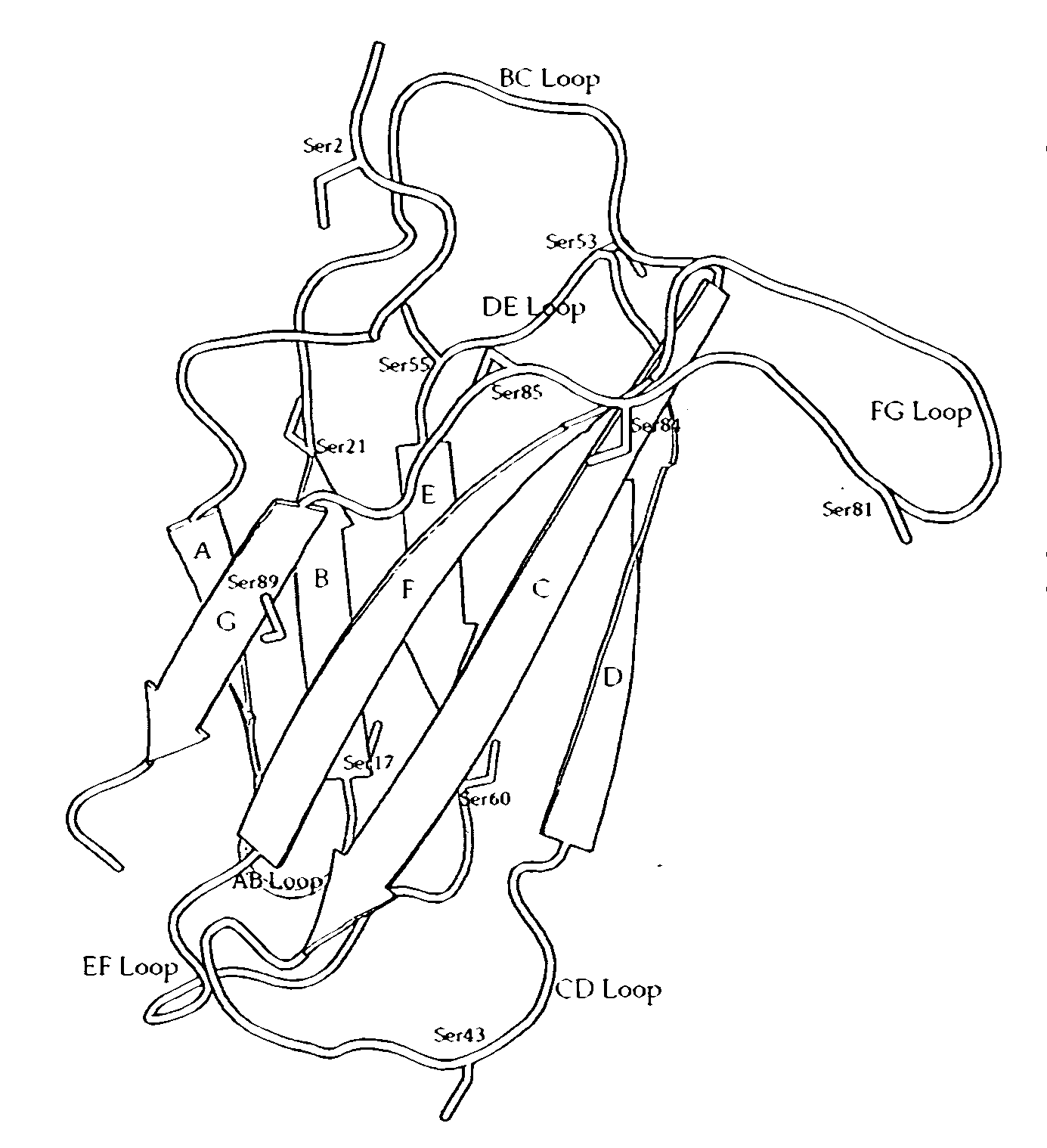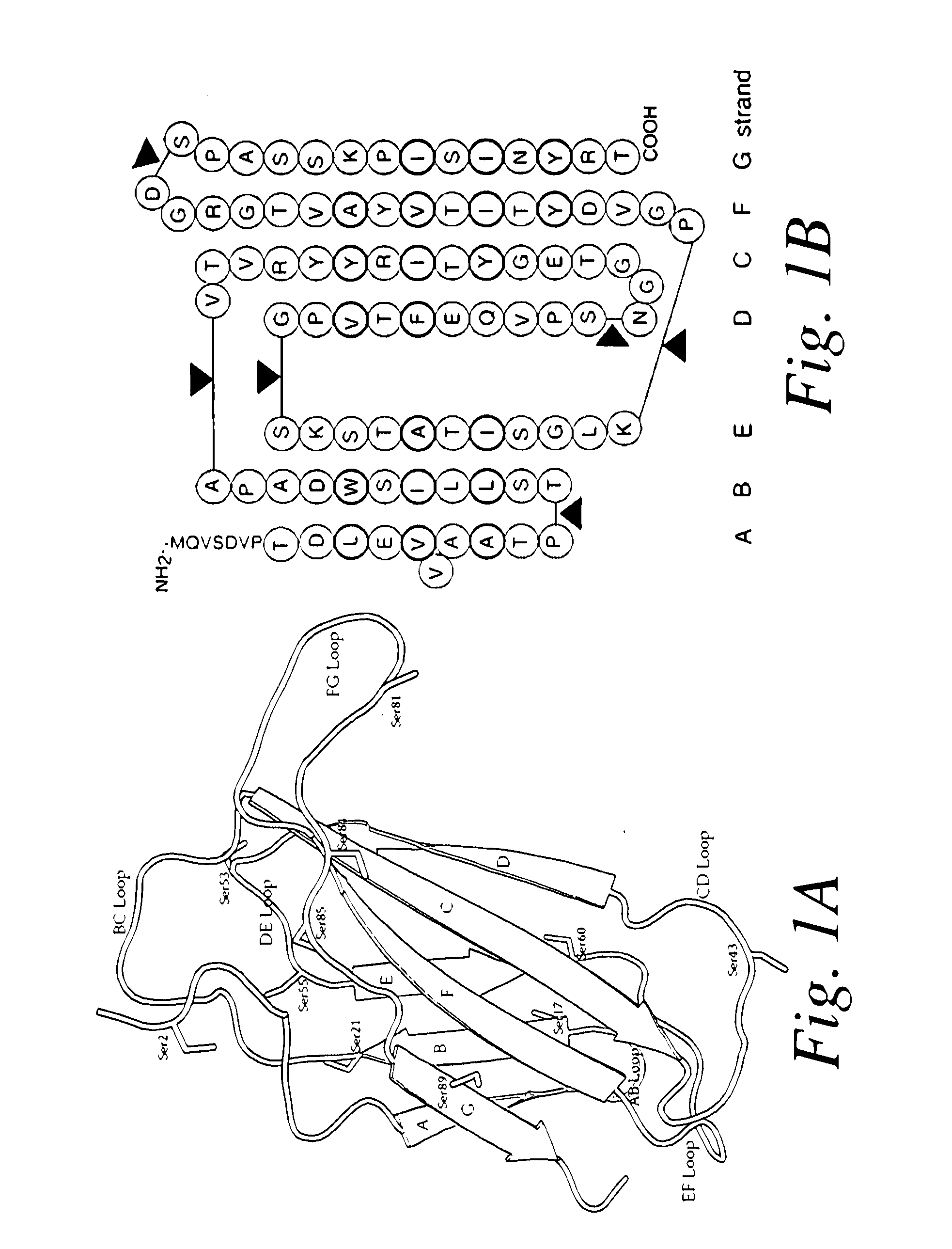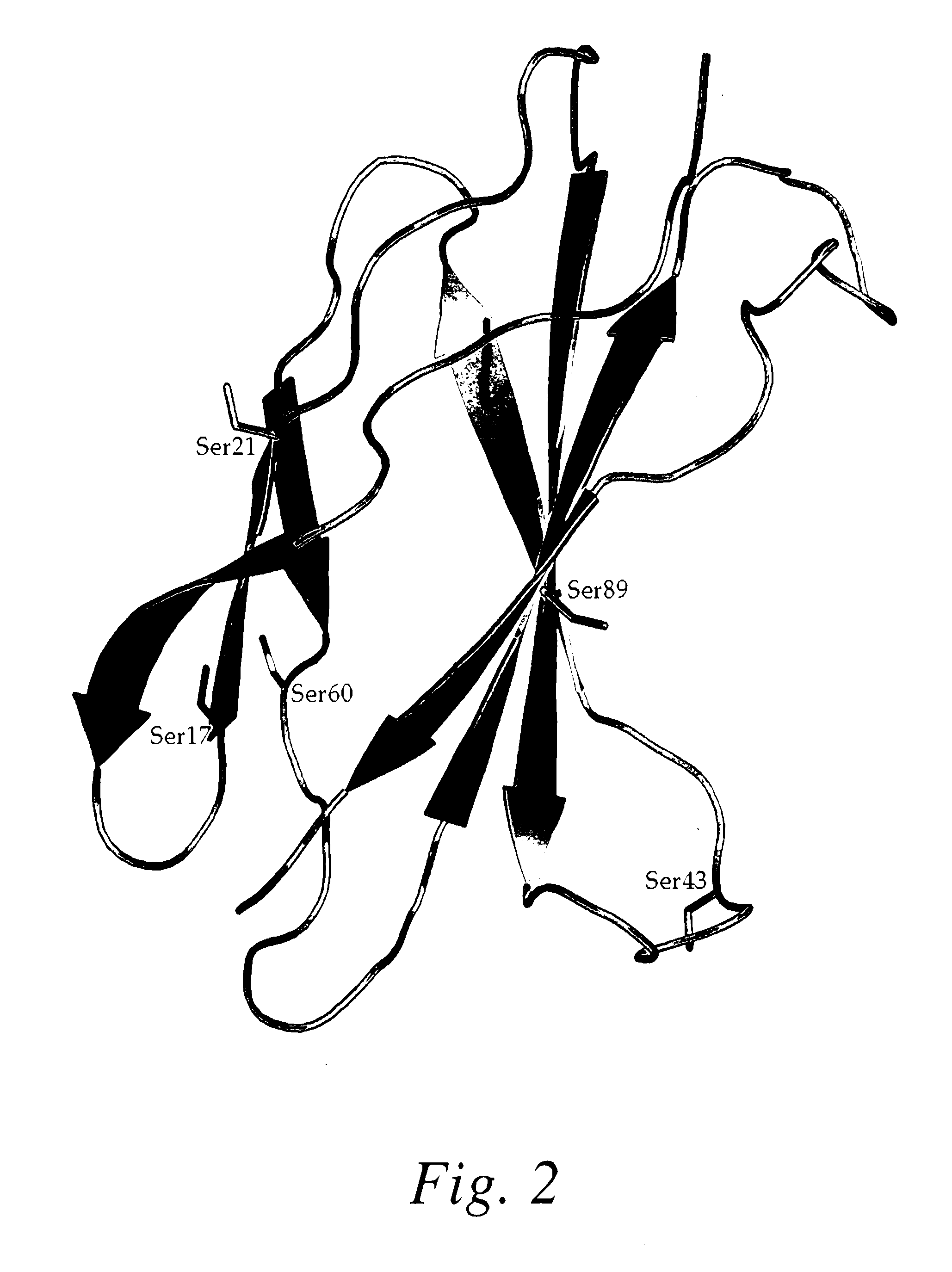Fibronectin-based binding molecules and their use
a technology of fibronectin and binding molecules, which is applied in the direction of depsipeptides, peptide/protein ingredients, unknown materials, etc., can solve the problems of undesired effector cell function and/or clotting cascades, limiting their therapeutic effectiveness, and affecting the efficiency of effector cells, so as to improve the half-life and stability, and increase the half-life of the molecule
- Summary
- Abstract
- Description
- Claims
- Application Information
AI Technical Summary
Benefits of technology
Problems solved by technology
Method used
Image
Examples
example 1
CDR Grafting
[0198]Using computational modeling, the CDR loop 1 (SGFTFSDYWM—SEQ ID NO: 35) and loop 3 (RSPSGFNR—SEQ ID NO: 36) from a TNF-binding nanobody (SEQ ID NO: 10) were grafted onto the framework of the wildtype tenth domain of the human fibronectin type III module (“10Fn3” or “wildtype Fn3”). The amino acid sequences of the TNF-binding nanobody and wildtype Fn3 molecule are as follows:
TNF-Binding Nanobody (SEQ ID NO: 10)
[0199]
QVQLVESGGGLVQPGGSLRLSCAASGFTFSDYWMYWVRQAPGKGLEWVSEINTNGLITKYPDSVKGRFTISRDNAKNTLYLQMNSLKPEDTALYYCARSPSGFNRGQGTQVTVSS
Wildtype Fn3 (SEQ ID NO: 1)
[0200]
VSDVPRDLEVVAATPTSLLISWDAPAVTVRYYRITYGETGGNSPVQEFTVPGSKSTATISGLKPGVDYTITVYAVTGRGDSPASSKPISINYRT
[0201]Using the same methods, the CDR loop 1 (SQAIDSY—SEQ ID NO: 38) and loop 3 (QVVWRPFT—SEQ ID NO: 39) from a TNF-binding single domain antibody (SEQ ID NO: 40) were grafted onto wildtype Fn3. The amino acid sequence of the TNF-binding single domain antibody is as follows:
TNF-Binding Single Domain Antibody (SEQ ID ...
example 2
Identification of Positions within the Fibronectin Molecule for Amino Acid Modifications
[0206]Based on a review of the wildtype Fn3 sequence, positions were identified as potential sites for amino acid modifications, e.g., for substitution with cysteine or non-naturally occurring amino acid residues to facilitate PEGylation. For example, the serine residues were analyzed as set forth below. There are 11 total Ser residues which are underlined in the sequence below; see also FIG. 1 which shows the wildtype Fn3 molecule with a stick representation of the serine residues)
Wildtype Fn3
[0207]
(SEQ ID NO: 1)VSDVPRDLEVVAATPTSLLISWDAPAVTVRYYRITYGETGGNSPVQEFTVPGSKSTATISGLKPGVDYTITVYAVTGRGDSPASSKPISINYRT
Serine residues which are located near the binding surface were excluded from the analysis, e.g., Ser 2 which belongs to the N-terminal region and which also contacts with the FG and BC loops (Ser residue underlined in the sequence below).
(SEQ ID NO: 1)VSDVPRDLEVVAATPTSLLISWDAPAVTVRYYRITYGETGGNS...
example 3
PEGylation of Fn3 Sequences
[0215]To increase the half-life of Fn, PEGylation of TNF-binding Fn3 (SEQ ID NO:3), TNF-binding Fn3 (R18L and I56T) (SEQ ID NO:4), wildtype Fn3 (SEQ ID NO:1) and wildtype Fn3 (RGD to RGA) (SEQ ID NO: 2) using (1) cysteine and (2) non-natural amino acids was conducted as follows.
TNF-Binding Fn3
[0216]
(SEQ ID NO: 3)VSDVPRDLEVVAATPTSRLISWNRSGLQSRYYRITYGETGGNSPVQEFTVPPWASIATISGLKPGVDYTITVYAVTDKSDTYKYDDPISINYRT
TNF-Binding Fn3 (R18L and I56T)
[0217]
(SEQ ID NO: 4)VSDVPRDLEVVAATPTSLLISWNRSGLQSRYYRITYGETGGNSPVQEFTVPPWASTATISGLKPGVDYTITVYAVTDKSDTYKYDDPISINYRT
Wildtype Fn3
[0218]
(SEQ ID NO: 1)VSDVPRDLEVVAATPTSLLISWDAPAVTVRYYRITYGETGGNSPVQEFTVPGSKSTATISGLKPGVDYTITVYAVTGRGDSPASSKPISINYRT
Wildtype Fn3 Sequence (RGD to RGA)
[0219]
(SEQ ID NO: 2)VSDVPRDLEVVAATPTSLLISWDAPAVTVRYYRITYGETGGNSPVQEFTVPGSKSTATISGLKPGVDYTITVYAVTGRGASPASSKPISINYRT
[0220]PEGylation Using Cysteine
[0221]The DNA sequences corresponding to the foregoing TNF-binding Fn3 and wildtype Fn3 sequences were optimised...
PUM
| Property | Measurement | Unit |
|---|---|---|
| Time | aaaaa | aaaaa |
| Time | aaaaa | aaaaa |
| Time | aaaaa | aaaaa |
Abstract
Description
Claims
Application Information
 Login to View More
Login to View More - R&D
- Intellectual Property
- Life Sciences
- Materials
- Tech Scout
- Unparalleled Data Quality
- Higher Quality Content
- 60% Fewer Hallucinations
Browse by: Latest US Patents, China's latest patents, Technical Efficacy Thesaurus, Application Domain, Technology Topic, Popular Technical Reports.
© 2025 PatSnap. All rights reserved.Legal|Privacy policy|Modern Slavery Act Transparency Statement|Sitemap|About US| Contact US: help@patsnap.com



